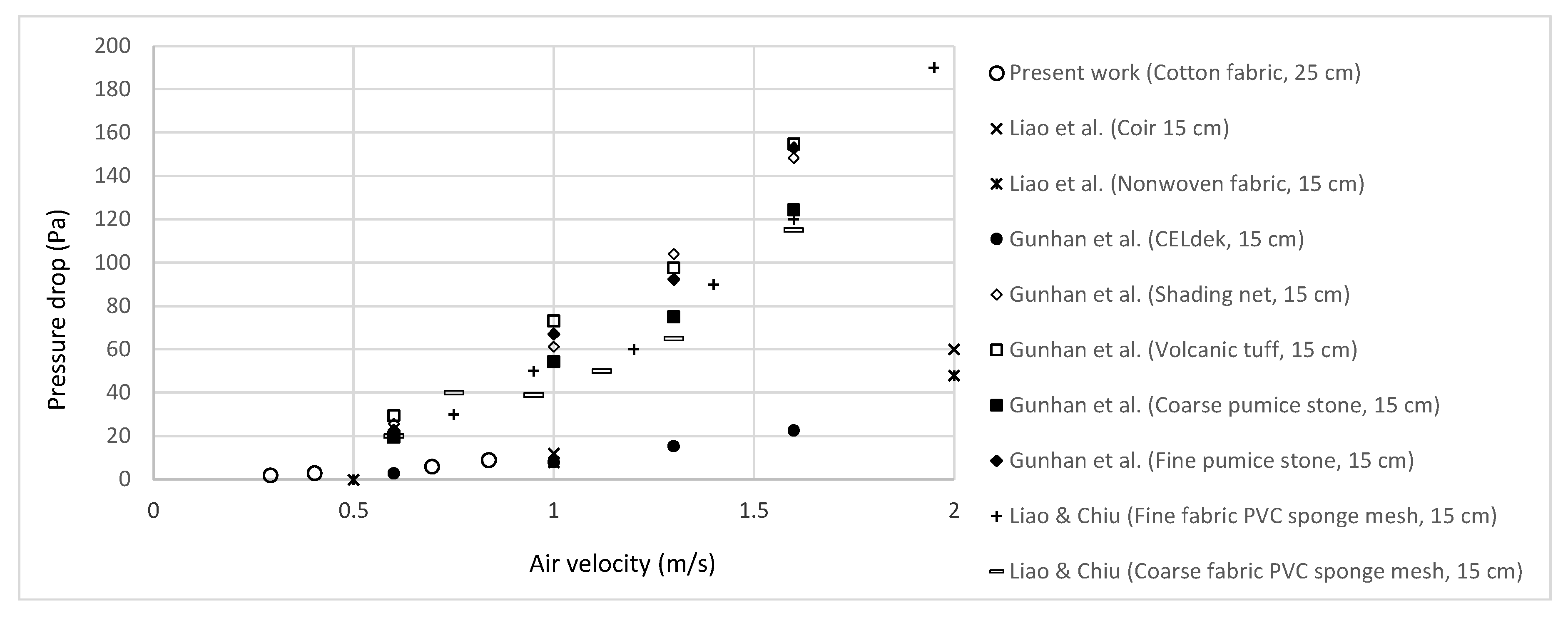Experimental Investigation of the Potential of a New Fabric-Based Evaporative Cooling Pad
Abstract
1. Introduction
2. Materials and Methods
2.1. Design and Construction of the Fabric EC System
2.2. Experimental Setup
2.3. Design of Experiments
3. Results
3.1. Saturation Efficiency
3.2. Air Humidification
3.3. Pressure Drop
3.4. Airborne Particles
4. Discussion
5. Conclusions
Author Contributions
Funding
Conflicts of Interest
References
- Watt, J.R. Evaporative Air Conditioning Handbook; 2.; Chapman and Hall: New York, NY, USA, 1986. [Google Scholar]
- Chapter 53 Evaporative Cooling. In ASHRAE Handbook. HVAC Applications; 2019. Available online: https://www.ashrae.org/technical-resources/ashrae-handbook/ashrae-handbook-online (accessed on 29 August 2020).
- Chapter 41 Evaporative Air-Cooling Equipment. In ASHRAE Handbook-Systems and Equipment; 2020. Available online: https://www.ashrae.org/technical-resources/ashrae-handbook/description-2020-ashrae-handbook-hvac-systems-and-equipment (accessed on 29 August 2020).
- Sheng, C.; Agwu Nnanna, A.G. Empirical correlation of cooling efficiency and transport phenomena of direct evaporative cooler. Appl. Therm. Eng. 2012, 40, 48–55. [Google Scholar] [CrossRef]
- Malli, A.; Seyf, H.R.; Layeghi, M.; Sharifian, S.; Behravesh, H. Investigating the performance of cellulosic evaporative cooling pads. Energy Convers. Manag. 2011, 52, 2598–2603. [Google Scholar] [CrossRef]
- Franco, A.; Valera, D.L.; Madueño, A.; Peña, A. Influence of Water and Air Flow on the Performance of Cellulose Evaporative Cooling Pads Used in Mediterranean Greenhouses. Trans. ASABE 2010, 53, 565–576. [Google Scholar] [CrossRef]
- Warke, D.A.; Deshmukh, S.J. Experimental Analysis of Cellulose Cooling Pads Used in Evaporative Coolers. Int. J. Energy Sci. Eng. 2017, 3, 37–43. [Google Scholar]
- Barzegar, M.; Layeghi, M.; Ebrahimi, G.; Hamzeh, Y.; Khorasani, M. Experimental evaluation of the performances of cellulosic pads made out of Kraft and NSSC corrugated papers as evaporative media. Energy Convers. Manag. 2012, 54, 24–29. [Google Scholar] [CrossRef]
- Al-Badri, A.R.; Al-Waaly, A.A.Y. The influence of chilled water on the performance of direct evaporative cooling. Energy Build. 2017, 155, 143–150. [Google Scholar] [CrossRef]
- He, S.; Guan, Z.; Gurgenci, H.; Hooman, K.; Lu, Y.; Alkhedhair, A.M. Experimental study of film media used for evaporative pre-cooling of air. Energy Convers. Manag. 2014, 87, 874–884. [Google Scholar] [CrossRef]
- Franco, A.; Valera, D.L.; Peña, A. Energy efficiency in greenhouse evaporative cooling techniques: Cooling boxes versus cellulose pads. Energies 2014, 7, 1427–1447. [Google Scholar] [CrossRef]
- Alam, M.F.; Sazidy, A.S.; Kabir, A.; Mridha, G.; Litu, N.A.; Rahman, M.A. An experimental study on the design, performance and suitability of evaporative cooling system using different indigenous materials. AIP Conf. Proc. 2017, 1851, 020075. [Google Scholar] [CrossRef]
- Jain, J.K.; Hindoliya, D.A. Experimental performance of new evaporative cooling pad materials. Sustain. Cities Soc. 2011, 1, 252–256. [Google Scholar] [CrossRef]
- Jain, J.K.; Hindoliya, D.A. Correlations for Saturation Efficiency of Evaporative Cooling Pads. J. Inst. Eng. Ser. C 2014, 95, 5–10. [Google Scholar] [CrossRef]
- Anyanwu, E.E. Design and measured performance of a porous evaporative cooler for preservation of fruits and vegetables. Energy Convers. Manag. 2004, 45, 2187–2195. [Google Scholar] [CrossRef]
- Rawangkul, R.; Khedari, J.; Hirunlabh, J.; Zeghmati, B. Performance analysis of a new sustainable evaporative cooling pad made from coconut coir. Int. J. Sustain. Eng. 2008, 1, 117–131. [Google Scholar] [CrossRef]
- Al-Sulaiman, F. Evaluation of the performance of local fibers in evaporative cooling. Energy Convers. Manag. 2002, 43, 2267–2273. [Google Scholar] [CrossRef]
- Ndukwu, M.C.; Manuwa, S.I. A techno-economic assessment for viability of some waste as cooling pads in evaporative cooling system. Int. J. Agric. Biol. Eng. 2015, 8, 151–158. [Google Scholar]
- De Melo, J.C.F.; Bamberg, J.V.M.; MacHado, N.S.; Caldas, E.N.G.; Rodrigues, M.S. Evaporative cooling efficiency of pads consisting of vegetable loofah. Comun. Sci. 2019, 10, 38–44. [Google Scholar] [CrossRef]
- Doğramacı, P.A.; Aydın, D. Comparative experimental investigation of novel organic materials for direct evaporative cooling applications in hot-dry climate. J. Build. Eng. 2020, 30. [Google Scholar] [CrossRef]
- Gunhan, T.; Demir, V.; Yagcioglu, A.K. Evaluation of the Suitability of Some Local Materials as Cooling Pads. Biosyst. Eng. 2007, 96, 369–377. [Google Scholar] [CrossRef]
- Laknizi, A.; Ben Abdellah, A.; Faqir, M.; Essadiqi, E.; Dhimdi, S. Performance characterization of a direct evaporative cooling pad based on pottery material. Int. J. Sustain. Eng. 2019, 00, 1–11. [Google Scholar] [CrossRef]
- Korese, J.K.; Hensel, O. Experimental evaluation of bulk charcoal pad configuration on evaporative cooling effectiveness. Agric. Eng. Int. CIGR J. 2016, 18, 11–21. [Google Scholar]
- Ahmed, E.M.; Abaas, O.; Ahmed, M.; Ismail, M.R. Performance evaluation of three different types of local evaporative cooling pads in greenhouses in Sudan. Saudi J. Biol. Sci. 2011, 18, 45–51. [Google Scholar] [CrossRef] [PubMed]
- Inamdar, S.J.; Junghare, A.; Kale, P. Performance enhancement of evaporative cooling by using bamboo. Int. J. Eng. Adv. Technol. 2019, 8, 856–860. [Google Scholar]
- Sudprasert, S.; Sankaewthong, S. Utilization of rice husks in a water-permeable material for passive evaporative cooling. Case Stud. Constr. Mater. 2018, 8, 51–60. [Google Scholar] [CrossRef]
- Xu, P.; Ma, X.; Zhao, X.; Fancey, K.S. Experimental investigation on performance of fabrics for indirect evaporative cooling applications. Build. Environ. 2016, 110, 104–114. [Google Scholar] [CrossRef]
- Liao, C.M.; Singh, S.; Wang, T. Sen Characterizing the performance of alternative evaporative cooling pad media in thermal environmental control applications. J. Environ. Sci. Health-Part A Toxic/Hazardous Subst. Environ. Eng. 1998, 33, 1391–1417. [Google Scholar]
- Liao, C.M.; Chiu, K.H. Wind tunnel modeling the system performance of alternative evaporative cooling pads in Taiwan region. Build. Environ. 2002, 37, 177–187. [Google Scholar] [CrossRef]
- Ghosal, M.K.; Tiwari, G.N.; Srivastava, N.S.L. Modeling and experimental validation of a greenhouse with evaporative cooling by moving water film over external shade cloth. Energy Build. 2003, 35, 843–850. [Google Scholar] [CrossRef]
- Esparza L., C.J.; Escobar del Pozo, C.; Gómez A., A.; Gómez A., G.; Gonzalez C., E. Potential of a wet fabric device as a roof evaporative cooling solution: Mathematical and experimental analysis. J. Build. Eng. 2018, 19. [Google Scholar] [CrossRef]
- Brown, W.K. Operation and Maintenance of Evaporative Coolers. ASHRAE J. 2000, 42, 27–31. Available online: https://technologyportal.ashrae.org/Journal/ArticleDetail/545 (accessed on 29 August 2020).
- Puckorius, P.R.; Thomas, P.T.; Augspurger, R.L. Why Evaporative Coolers have not caused Legionnaires’ disease. ASHRAE J. 1995, 1, 29–33. [Google Scholar]
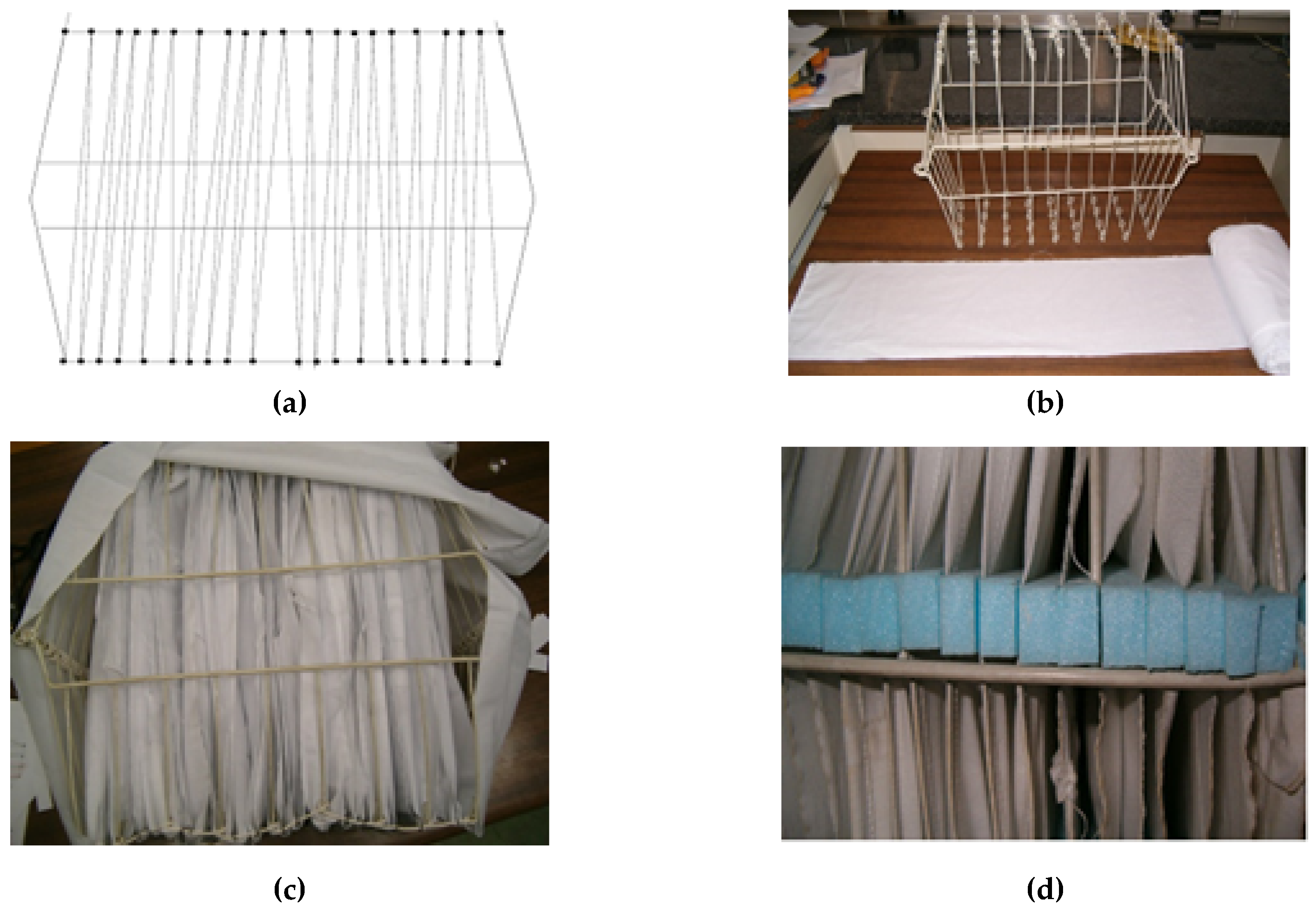
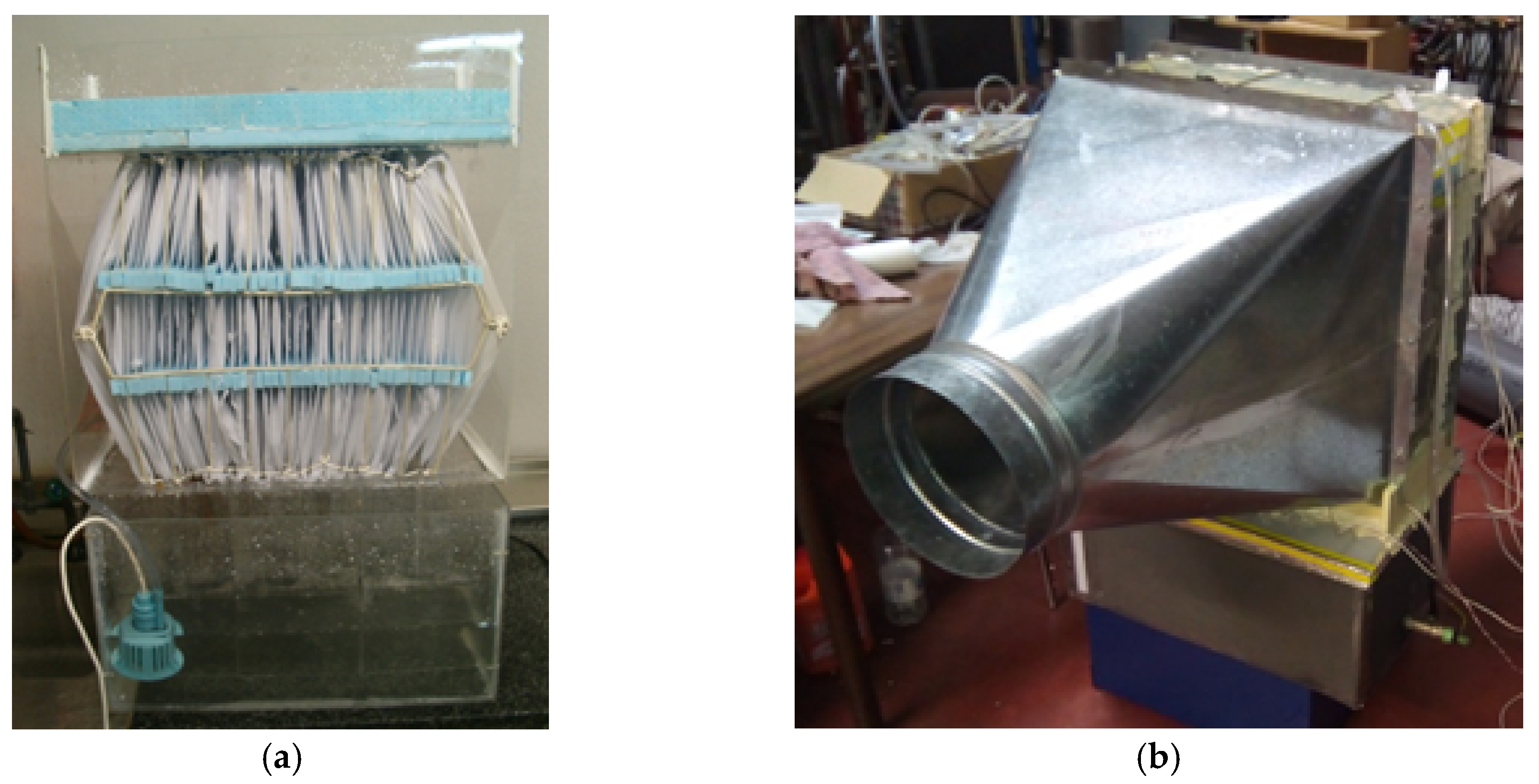
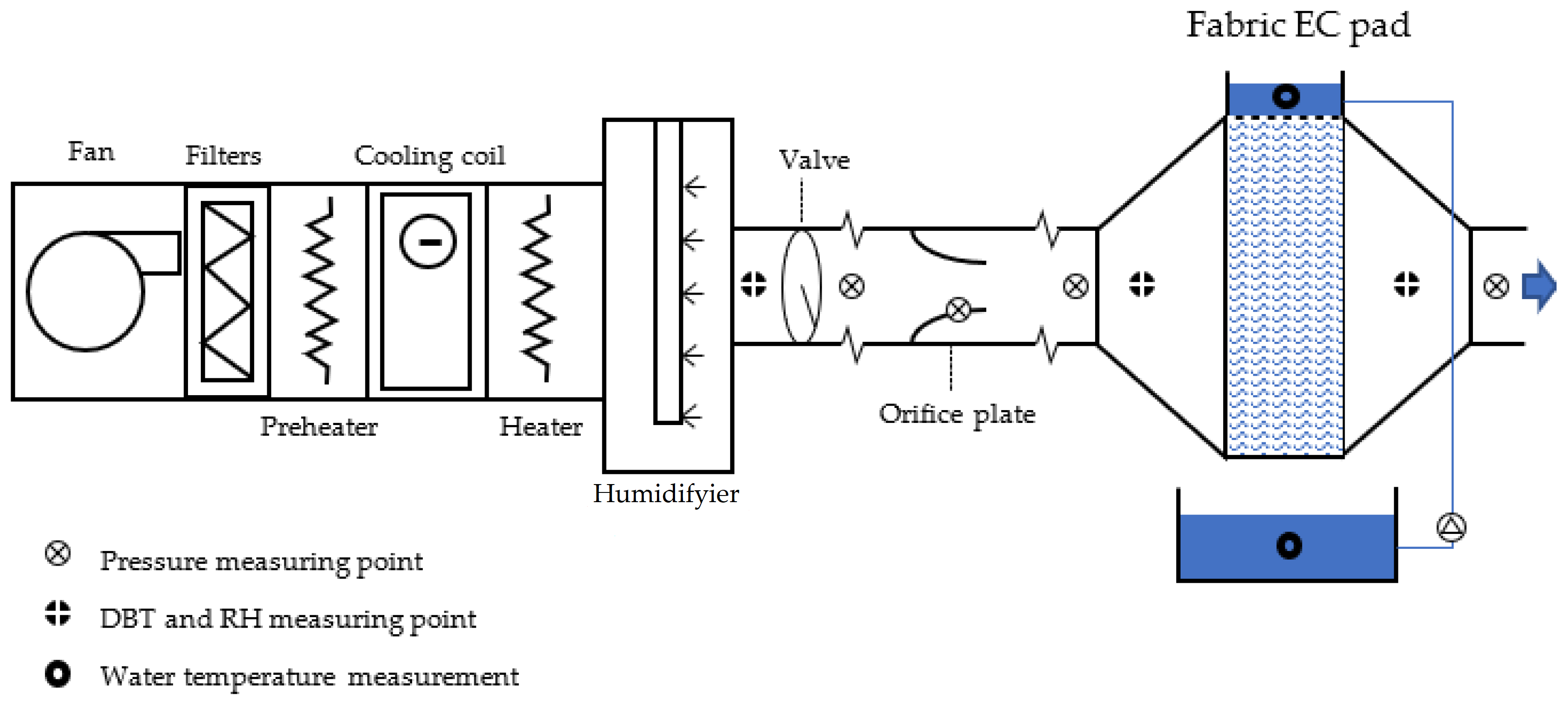



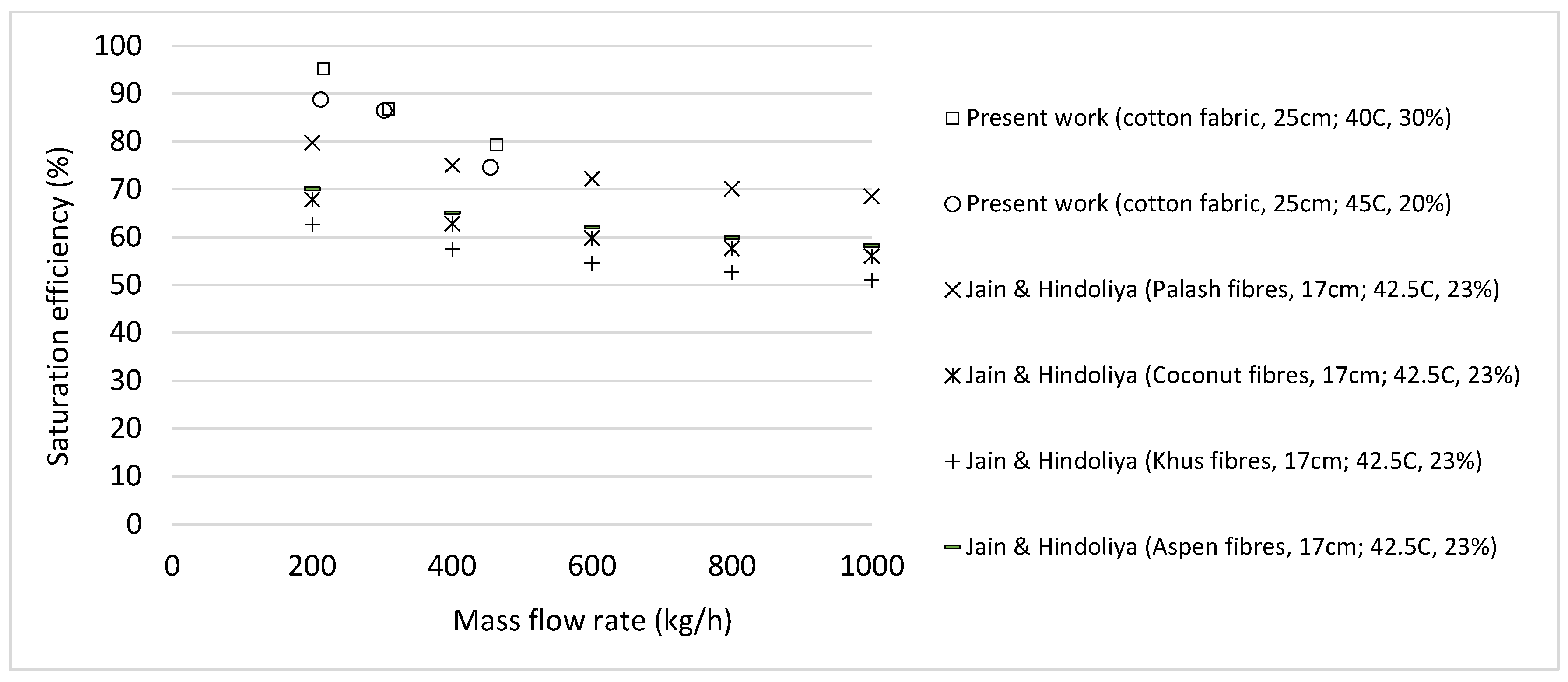
| Airflow [m3/h] | Specific Humidity [kgv/kgda] | DBT [°C] | |||||
|---|---|---|---|---|---|---|---|
| T1 25 °C | T2 30 °C | T3 35 °C | T4 40 °C | T5 45 °C | T6 50 °C | ||
| V1 210 | W1 0.0115 | V1T1W1 (1) | V1T2W1 (8) | V1T3W1 (16) | V1T4W1 (10) | V1T5W1 (6) | V1T6W1 (13) |
| W2 0.0150 | V1T1W2 (9) | V1T2W2 (3) | V1T3W2 (5) | V1T4W2 (12) | V1T5W2 (14) | V1T6W2 (17) | |
| W3 0.0195 | V1T1W3 (11) | V1T2W3 (7) | V1T3W3 (2) | V1T4W3 (4) | V1T5W3 (15) | V1T6W3 (18) | |
| V2 300 | W1 0.0115 | V2T1W1 (43) | V2T2W1 (49) | V2T3W1 (37) | V2T4W1 (47) | V2T5W1 (52) | V2T6W1 (40) |
| W2 0.0150 | V2T1W2 (42) | V2T2W2 (39) | V2T3W2 (46) | V2T4W2 (50) | V2T5W2 (45) | V2T6W2 (53) | |
| W3 0.0195 | V2T1W3 (54) | V2T2W3 (48) | V2T3W3 (51) | V2T4W3 (38) | V2T5W3 (44) | V2T6W3 (41) | |
| V3 450 | W1 0.0115 | V3T1W1 (32) | V3T2W1 (22) | V3T3W1 (19) | V3T4W1 (27) | V3T5W1 (24) | V3T6W1 (30) |
| W2 0.0150 | V3T1W2 (36) | V3T2W2 (34) | V3T3W2 (21) | V3T4W2 (31) | V3T5W2 (26) | V3T6W2 (28) | |
| W3 0.0195 | V3T1W3 (23) | V3T2W3 (33) | V3T3W3 (35) | V3T4W3 (20) | V3T5W3 (29) | V3T6W3 (25) | |
| Airflow [m3/h] | Specific Humidity [kgv/kgda] | DBT [°C] | |||||
|---|---|---|---|---|---|---|---|
| T1 25 °C | T2 30 °C | T3 35 °C | T4 40 °C | T5 45 °C | T6 50 °C | ||
| V1 210 | W1 0.0115 | 25.2 °C 55.0% | 29.6 °C 45.3% | 36.4 °C 30.6% | 39.7 °C 30.3% | 46.5 °C 17.7% | 48.5 °C 15.4% |
| W2 0.0150 | 24.6 °C 84.8% | 30.5 °C 55.9% | 35.9 °C 43.0% | 40.0 °C 32.3% | 46.0 °C 21.9% | 48.5 °C 17.1% | |
| W3 0.0195 | 25.2 °C 100 % | 29.2 °C 71.4% | 36.3 °C 55.0% | 39.6 °C 48.8% | 46.6 °C 29.2% | 50.2 °C 22.3% | |
| V2 300 | W1 0.0115 | 25.8 °C 55.8% | 30.0 °C 44.8% | 34.6 °C 33.7% | 39.9 °C 27.4% | 45.3 °C 22.0% | 51.5 °C 14.6% |
| W2 0.0150 | 25.2 °C 71.7% | 30.3 °C 60.2% | 34.9 °C 45.5% | 40.0 °C 39.5% | 45.2 °C 29.8% | 50.9 °C 20.2% | |
| W3 0.0195 | 25.3 °C 81.4% | 30.0 °C 72.5% | 34.9 °C 63.1% | 40.8 °C 48.6% | 45.9 °C 36.1% | 51.6 °C 28.5% | |
| V3 450 | W1 0.0115 | 25.2 °C 58.0% | 30.4 °C 43.9% | 35.9 °C 31.5% | 41.5 °C 30.6% | 45.9 °C 16.9% | 52.0 °C 18.6% |
| W2 0.0150 | 25.0 °C 69.7% | 30.0 °C 61.6% | 35.7 °C 45.3% | 41.5 °C 31.6% | 46.8 °C 28.8% | 48.0 °C 20.8% | |
| W3 0.0195 | 25.2 °C 93.0% | 30.0 °C 69.2% | 35.0 °C 58.7% | 41.4 °C 47.4% | 43.2 °C 39.3% | 51.1 °C 23.3% | |
| Airflow [m3/h] | Specific Humidity [kgv/kgda] | DBT [°C] | |||||
|---|---|---|---|---|---|---|---|
| T1 25 °C | T2 30 °C | T3 35 °C | T4 40 °C | T5 45 °C | T6 50 °C | ||
| V1 210 | W1 0.0115 | 20.1 °C 86.0% | 20.5 °C 87.9% | 23.7 °C 77.0% | 25.2 °C 83.8% | 27.0 °C 87.7% | 29.3 °C 83.1% |
| W2 0.0150 | 20.1 °C 100% | 23.4 °C 97.8% | 26.0 °C 95.7% | 26.0 °C 91.1% | 28.2 °C 88.7% | 29.8 °C 74.4% | |
| W3 0.0195 | 22.7 °C 100% | 23.6 °C 100% | 26.6 °C 94.0% | 27.7 °C 94.1% | 30.2 °C 94.5% | 32.0 °C 93.4% | |
| V2 300 | W1 0.0115 | 18.8 °C 91.9% | 21.4 °C 87.3% | 23.5 °C 85.8% | 25.9 °C 80.1% | 28.2 °C 76.6% | 30.3 °C 74.0% |
| W2 0.0150 | 20.9 °C 100% | 22.9 °C 100% | 25.3 °C 92.8% | 27.8 °C 88.2% | 29.4 °C 81.8% | 31.3 °C 74.0% | |
| W3 0.0195 | 21.6 °C 100% | 24.3 °C 100% | 27.1 °C 100% | 29.0 °C 100% | 31.2 °C 90.8% | 32.8 °C 84.7% | |
| V3 450 | W1 0.0115 | 19.6 °C 90.0% | 22.2 °C 87.6% | 25.9 °C 70.5 % | 29.1 °C 72.8 % | 29.5 °C 71.7 % | 34.2 °C 69.5% |
| W2 0.0150 | 21.0 °C 100% | 23.8 °C 95.8 % | 26.3 °C 89.7 % | 29.5 °C 74.4 % | 32.8 °C 73.5 % | 32.1 °C 74.4% | |
| W3 0.0195 | 23.1 °C 99% | 25.7 °C 100% | 27.0 °C 98.1 % | 30.7 °C 92.1 % | 32.0 °C 89.0 % | 37.4 °C 68.9% | |
| Airflow [m3/h] | Specific Humidity [kgv/kgda] | DBT [°C] | |||||
|---|---|---|---|---|---|---|---|
| T1 25 °C | T2 30 °C | T3 35 °C | T4 40 °C | T5 45 °C | T6 50 °C | ||
| V1 210 | W1 0.0115 | 17.1 °C | 17.7 °C | 20.0 °C | 20.9 °C | 21.6 °C | 22.1 °C |
| W2 0.0150 | 19.9 °C | 21.3 °C | 22.0 °C | 22.6 °C | 23.5 °C | 23.7 °C | |
| W3 0.0195 | 22.2 °C | 22.7 °C | 23.0 °C | 24.4 °C | 26.0 °C | 26.7 °C | |
| V2 300 | W1 0.0115 | 16.7 °C | 18.0 °C | 19.2 °C | 20.4 °C | 21.8 °C | 22.4 °C |
| W2 0.0150 | 20.0 °C | 20.4 °C | 21.6 °C | 22.9 °C | 22.7 °C | 24.3 °C | |
| W3 0.0195 | 21.1 °C | 21.8 °C | 23.8 °C | 24.6 °C | 24.5 °C | 25.6 °C | |
| V3 450 | W1 0.0115 | 16.9 °C | 19.3 °C | 19.6 °C | 20.7 °C | 21.4 °C | 23.5 °C |
| W2 0.0150 | 19.5 °C | 20.7 °C | 22.1 °C | 22.3 °C | 23.7 °C | 23.7 °C | |
| W3 0.0195 | 21.1 °C | 22.7 °C | 22.9 °C | 25.9 °C | 24.9 °C | 25.4 °C | |
| Pressure Drop in the Orifice Plate (Pa) | Air volume Flow (m3/h) | Pressure Drop in the Fabric EC System (Pa) |
|---|---|---|
| 766 | 543 | 9 |
| 531 | 451 | 6 |
| 179 | 261 | 3 |
| 95 | 190 | 2 |
| Media | Airflow (m3/h) | Test No. | Particle Size | ||||||
|---|---|---|---|---|---|---|---|---|---|
| 0.3 µm | 0.5 µm | 1 µm | 5 µm | 10 µm | 25 µm | Total | |||
| Dry | V1 | 1 | 300493 | 137149 | 58035 | 1704 | 290 | 18 | 497689 |
| 6 | 304787 | 128504 | 53955 | 1694 | 229 | 7 | 489176 | ||
| V2 | 2 | 297348 | 129643 | 50795 | 1227 | 197 | 6 | 479216 | |
| 4 | 294970 | 122589 | 45750 | 1054 | 140 | 3 | 464506 | ||
| V3 | 3 | 298592 | 133134 | 52997 | 1010 | 103 | 9 | 485845 | |
| 5 | 294268 | 121133 | 44317 | 783 | 88 | 7 | 460596 | ||
| Wet | V1 | 7 | 330227 | 112532 | 42305 | 1111 | 124 | 6 | 486305 |
| 8 | 332127 | 111734 | 42688 | 1209 | 134 | 7 | 487899 | ||
| V2 | 9 | 327564 | 101634 | 33258 | 658 | 70 | 4 | 463188 | |
| 12 | 346768 | 106485 | 34215 | 598 | 72 | 2 | 488140 | ||
| V3 | 10 | 333924 | 110254 | 40466 | 798 | 86 | 4 | 485532 | |
| 11 | 334664 | 105435 | 35631 | 553 | 57 | 2 | 476342 | ||
© 2020 by the authors. Licensee MDPI, Basel, Switzerland. This article is an open access article distributed under the terms and conditions of the Creative Commons Attribution (CC BY) license (http://creativecommons.org/licenses/by/4.0/).
Share and Cite
Velasco-Gómez, E.; Tejero-González, A.; Jorge-Rico, J.; Rey-Martínez, F.J. Experimental Investigation of the Potential of a New Fabric-Based Evaporative Cooling Pad. Sustainability 2020, 12, 7070. https://doi.org/10.3390/su12177070
Velasco-Gómez E, Tejero-González A, Jorge-Rico J, Rey-Martínez FJ. Experimental Investigation of the Potential of a New Fabric-Based Evaporative Cooling Pad. Sustainability. 2020; 12(17):7070. https://doi.org/10.3390/su12177070
Chicago/Turabian StyleVelasco-Gómez, Eloy, Ana Tejero-González, Javier Jorge-Rico, and F. Javier Rey-Martínez. 2020. "Experimental Investigation of the Potential of a New Fabric-Based Evaporative Cooling Pad" Sustainability 12, no. 17: 7070. https://doi.org/10.3390/su12177070
APA StyleVelasco-Gómez, E., Tejero-González, A., Jorge-Rico, J., & Rey-Martínez, F. J. (2020). Experimental Investigation of the Potential of a New Fabric-Based Evaporative Cooling Pad. Sustainability, 12(17), 7070. https://doi.org/10.3390/su12177070




